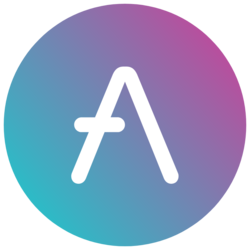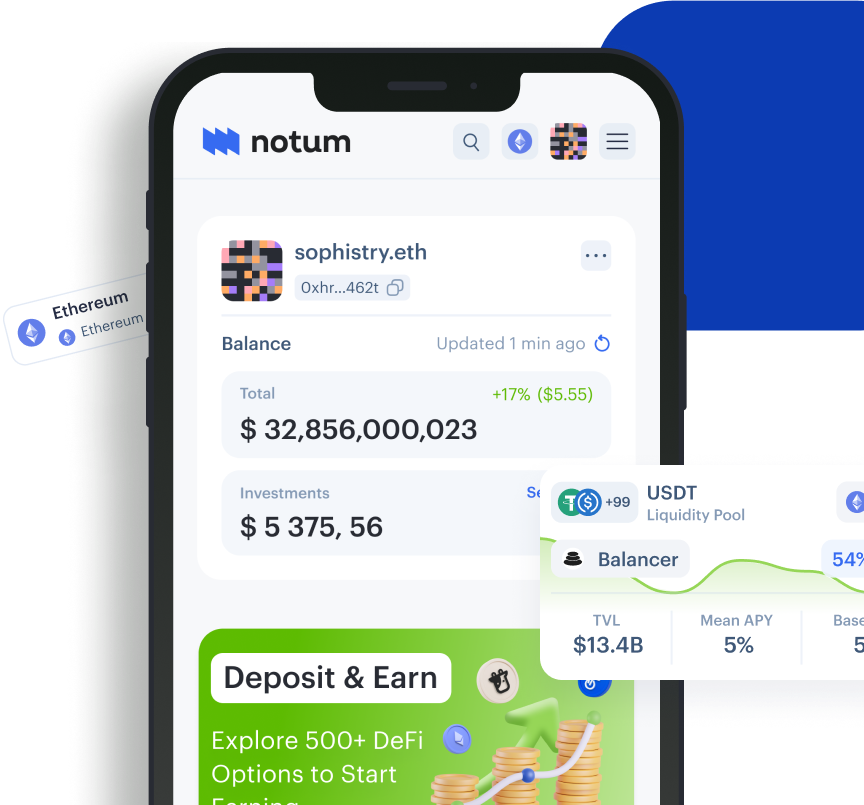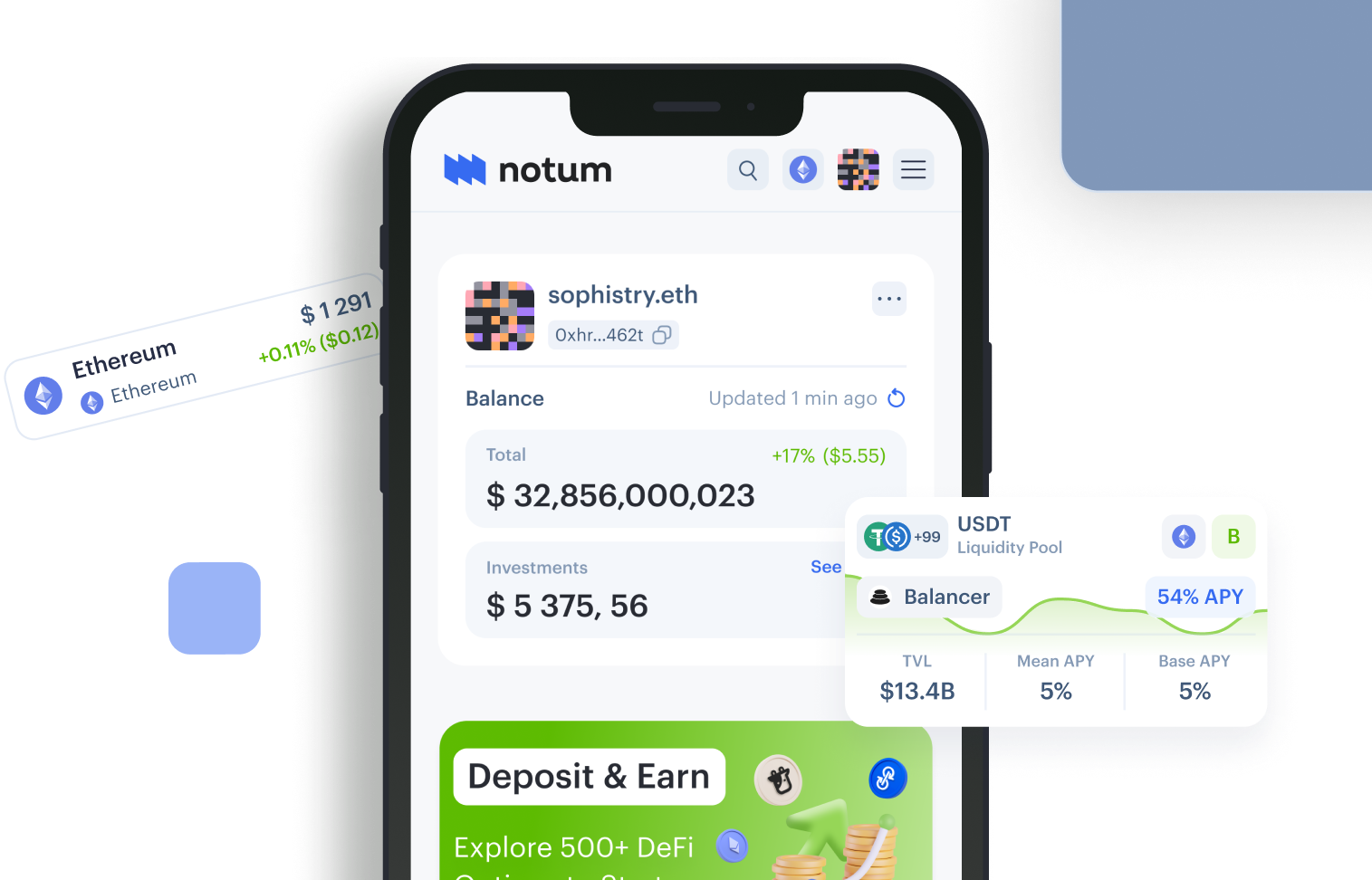Aave Protocol
Power your funds up with Aave and Notum lending strategies.


Aave Protocol Stats
$ 17.3B
Total TVL Across All Supported Networks
Medium Risk
Generally considered as balanced risk-reward investment
Active
Hands-on management for higher returns
3.1%
Average APY you can expect on Notum
How to Invest in Aave on Notum
The traditional financial system is almost impossible to imagine without lending. Lenders who receive interest for lending their assets and borrowers who need funds to buy or pay for services make up the economic activity of most countries. However, lending is also often associated with debt, defaults, additional fees, and penalties for late payments. DeFi (or Decentralized Finance) is a modern alternative to the existing system that uses blockchain technology and removes the existing imperfections of TradFi.
To obtain financing from a bank, a potential borrower must pass several checks. In addition to the eligibility criteria, which vary depending on the financial institution, creditworthiness is an important component. Depending on the credit history (which includes previous loans, their variety, capital, assets, etc.), a credit rating is formed, which affects the decision to grant a loan and the interest rates that will need to be paid. Thus, not every person has access to traditional lending.
Because DeFi is not run by the government or banks, funding is available to almost everyone. However, investors also need to secure their assets, which is why DeFi loans are secured, which has led to lending protocols. Today we will look at one of the leading DeFi lending protocols that you can use - Aave, how it works, how it differs from others, and how lending and borrowing work.
What Is Aave Protocol?
Aave is a popular cryptocurrency lending platform for borrowing and lending crypto assets. Aave describes itself as a “decentralized non-custodial liquidity protocol”, which can be considered the first DeFi lending protocol. It was launched back in 2017 under the name ETHLend as a P2P platform, which happened before the advent of DeFi itself. Initially, ETHLend can be compared to a kind of marketplace where borrowers and lenders could interact directly without third parties, unlike traditional lending.
The platform was founded by law student Stani Kulechov and remained successful in its field, but in 2020, after switching to the liquidity pool model, it was renamed Aave and became a more serious space in the DeFi world. Thus, Aave became an entirely new protocol that offered innovative features that changed the DeFi market.
Aave can now be described as a liquidity platform that facilitates the lending process between borrowers and lenders. While traditional lending uses a peer-to-peer model and requires third-party intervention, Aave uses a peer-to-pool where lender and borrower are equal. The platform takes liquidity from users who have assets and want to earn interest and lends it to those who need it.
Importance of Aave in DeFi
Aave is an incredibly popular protocol that has an important place in DeFi. The success of the platform is demonstrated by the fact that its TVL in smart contracts is more than 7.9 billion dollars. In addition, Aave is constantly updated. Since its launch, the protocol has already undergone two updates:
Aave V2. The goal of V2 in 2020 was to upgrade the lending features so that users can now borrow at both fixed and variable rates at the same time. Apart from this, V2 has also optimized gas fees.
Aave V3. March 2022 was also a key event in the history of the platform as the highly anticipated V3 was launched. Now the protocol has moved to cross-chain and supports various EVM-compatible first-level blockchains. "Aave V3 also increased capital efficiency and introduced Portals (bridges between supplied funds allowing the seamless movement of assets across chains)." - Nansen.
Aave is exactly the platform that made the process of lending and receiving investments not only simple but also fast. In addition, users also can receive so-called unsecured flash loans from the DeFi lending market. Aave is also important for the crypto world as now through this platform you can also earn interest on stablecoins.
How Does Aave Work?
As said, Aave platform lends and borrows cryptocurrencies and other types of digital assets. Thus, depending on your purpose, you can either earn interest on Aave loan or borrow for your own needs. Even though the protocol charges a certain fee for the mentioned flash loans, you can find tokens that do not have a transaction fee. However, how exactly does the protocol carry out transactions?
Unlike P2P, Aave uses liquidity pools as lending pools. Smart contracts allow a lender to provide assets, after which borrowers can borrow according to set interest rates and limits. Simply put, smart contracts (where liquidity is stored) have been noticed by centralized intermediaries such as banks and credit unions.
How to Use Aave?
To borrow with Aave, users must deposit a supported crypto, after which they receive payments for providing their asset. The amount they will receive varies depending on the demand for a particular asset (the situation with borrowing is similar). Some assets have stable interest rates, which is a big advantage for users who want to know the exact amount of fees or interest they owe to a lender.
Another strong side is that lenders can withdraw their funds at any time. Also Aave, like other lending protocols, "offers overcollateralized loans, meaning that a user must lock an amount of collateral that is larger than the amount being withdrawn." - Coinbureau. It is rather difficult to name a specific amount of Aave lending rates since it varies depending on the asset, but as a rule, it is 50-75%. Now, the Aave platform supports more than 17 crypto assets, including well-known DAI, USDC, USDT, BUSD, ETH and others.
What Makes Aave Unique?
Aave has scaled to become one of the most popular protocols due in large part to its distinctive features and benefits. First, as already mentioned, the V3 update includes the transition to cross-chain, which greatly simplifies access to assets in several chains. In addition, ease of use is largely due to the portal system.
Another unique feature of the platform is instant lending and borrowing. So-called flash loans are carried out in one block and have no limit on the amount of the loan because they are returned in the same transaction. Smart contracts replace the intermediary, and if the borrower is unable to repay the loan, the transaction is automatically canceled, and the lender gets his money back. Another hallmark of Aave is its open-source code. Thus, developers can use the protocol according to their needs and have access to all its functions.
For residents of Europe, Aave offers a feature such as Aave Pay, which allows users to quickly send fiat money to each other in exchange for their crypto assets. Moreover, since some cryptocurrencies have stable rates, the payout process becomes even more convenient and manageable.
Lending and Borrowing on Aave
Despite the ease of use of the platform, several steps must be taken to gain access to lending. Let's look at borrowing and lending separately.
- Borrowing. First, to borrow money on the platform, the user deposits collateral, the amount of which must be higher than the amount of loans. After that, users can go to the dashboard and borrow the funds they need. If the borrower cannot repay the loan, the platform sells its collateral to recover the funds. The process is automatic, so Aave liquidity pools remain positive and funds are also withdrawn from them. Before borrowing, do not forget to conduct an independent market analysis and assess the risks.
- Lending. Since lending on the Aave platform is decentralized, the process is as simple, comfortable, and safe as possible. Aave is a guarantee that the lender's assets are protected by the reserves that are on the platform (which also provide additional protection against market volatility). The platform offers many pools where the lender can earn interest for providing assets.
Thus, the user selects a blockchain market, connects their wallet to the platform, and then selects an asset (from those supported by the platform) that they want to borrow. In addition, investors need to decide on the loan amount and whether he wants to receive variable or stable interest rates.
Stargate: Investment Strategies
At the moment, Aave offers a huge number of different investment strategies with stable income. Let's look at two popular Aave pools for depositing assets and generating rewards on Notum:
https://app.notum.ai/investments/0x23878914efe38d27c4d67ab83ed1b93a74d4086a?protocol=Aave+V3&chainId=1
This investment strategy on Aave V3 allows users to deposit their USDT cryptocurrency to earn income. The pool operates on Ethereum and has a fairly low level of risk due to the huge total value locked of more than $71 million and no permanent loss. This strategy brings investors from 4% to 5% APY on average.
https://app.notum.ai/investments/0x028171bca77440897b824ca71d1c56cac55b68a3?protocol=Aave+V2&chainId=1
Another popular low-risk strategy from Aave V2 invites users to invest DAI on Ethereum to earn rewards. This pool also has an impressive TVL of more than $11 million and is not affected by permanent loss. Rewards for providing liquidity to the pool range from 11% to 12% APY.
Aave Interest Rates
Pool’s utilization rate directly affects the interest rates on the platform, because the higher it is, the more favorable the rate the lender will receive. That is why users who provide assets make deposits to the pool - this greatly reduces the risks.
It is also important to note that a high utilization rate also encourages borrowers to repay their debts as quickly as possible, otherwise, they will be forced to pay a higher price. Even though stable interest rates are predictable, they tend to be higher for the borrower as they reduce their risks. Variable interest rates depend on the situation in the market and are most suitable for short-term loans.
Why Use Aave?
Aave is one of the leading protocols for borrowing and lending crypto assets, which offers not only stable interest rates and collateralized loans, but also large lending pools for cryptocurrencies. Aave is currently the top choice for DeFi lending transactions and has the largest range of collateral and liquidity to support its market share. Even though some projects still compete with Aave, this platform has every chance to take a leading position in the near future.
Disclaimer: Notum does not provide any investment, tax, legal, or accounting advice. This article is written for informational purposes only. Cryptocurrency is subject to market risk. Please do your own research and trade with caution.
Boost Your Passive Income
Choose from a wide range of investments on Notum. Compare. Make a move.
Get started


FAQ
1.
What is Aave?
Aave is a fairly popular decentralized non-custodial liquidity protocol for borrowing and lending crypto assets. It simplifies the lending process between borrowers and lenders by using a peer-to-pool model with no central intermediaries or third parties.
2.
How does Aave work?
Aave allows users to earn money by providing liquidity and take out crypto loans for their own needs. The protocol uses liquidity pools as lending pools, where smart contracts have replaced centralized intermediaries such as banks, making the lending process simple and accessible.
3.
Is it safe to lend on Aave?
Aave protocol is open source and has a robust security system which makes it pretty safe to use. In addition, the platform has passed several audits and has a bug bounty program to identify vulnerabilities. However, like any DeFi protocol, Aave is subject to minimal risks associated with smart contracts and market volatility.
4.
What are Aave's fees?
According to the protocol’s official website, transaction fees for using the Ethereum blockchain depend on the network status and transaction complexity. In the case of Flash Loans, the borrower must pay a 0.09% fee.
5.
How does Aave pay interest?
Aave users deposit their cryptocurrency into the protocol, which is then given to borrowers at an interest rate. For providing liquidity, investors receive interest received from borrowers, minus protocol fees.
6.
What's the AAVE token used for?
Aave’s native cryptocurrency can be used for governance, which allows holders to participate in decisions regarding protocol upgrades and changes. Besides, users can stake AAVE to earn rewards and a share of the platform's fees. Furthermore, AAVE token can be a collateral to secure loans and access liquidity on the platform.